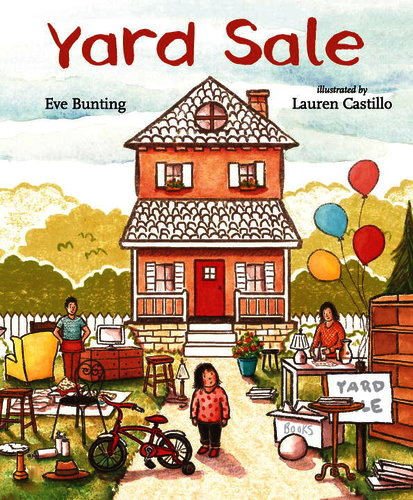 In Katherine Applegate’s new novel Crenshaw (Grades 5-9, Lexile 540), 10-year-old Jackson is consumed with worry as he watches his parents flounder under the weight of financial difficulties. Even though he’s young, he already has experience with these familiar adult stressors and remembers a time when his family was homeless. Jackson understands where the family is headed and is working hard to protect his little sister from the fear and uncertainty that grips him. Silently soldiering on and pretending all will be well, Jackson takes his cue from his parents by pretending it’s absolutely normal to sell furniture and necessary belongings right out from under the family. But, truth be told, no one in the family is buying the normalcy of their situation. And then Crenshaw appears, Jackson’s imaginary friend who he hasn’t seen since the family’s last financial crisis. Why has Crenshaw reappeared? How will Crenshaw help Jackson? How will Jackson’s family deal with this latest crisis?
In Katherine Applegate’s new novel Crenshaw (Grades 5-9, Lexile 540), 10-year-old Jackson is consumed with worry as he watches his parents flounder under the weight of financial difficulties. Even though he’s young, he already has experience with these familiar adult stressors and remembers a time when his family was homeless. Jackson understands where the family is headed and is working hard to protect his little sister from the fear and uncertainty that grips him. Silently soldiering on and pretending all will be well, Jackson takes his cue from his parents by pretending it’s absolutely normal to sell furniture and necessary belongings right out from under the family. But, truth be told, no one in the family is buying the normalcy of their situation. And then Crenshaw appears, Jackson’s imaginary friend who he hasn’t seen since the family’s last financial crisis. Why has Crenshaw reappeared? How will Crenshaw help Jackson? How will Jackson’s family deal with this latest crisis?
Jackson’s first-person point of view carries readers away with his experiences, emotions and thoughts. The themes of friendship, family relationships, social issues, homelessness, facing life’s fears and honesty run throughout the story. The importance of friends helping individuals deal with life’s hardships is shown through the friendship between Crenshaw and Jackson. Although Crenshaw is an imaginary friend, he has much to teach Jackson about asking for help when it is needed, being honest even if the truth hurts and accepting life’s unfortunate circumstances. Furthermore, the special bond between Jackson and his sister, Robin, is endearing, supportive and full of love. Family relationships are unique, complicated, difficult and one of a kind.
It is important to understand the gravity of the social issues tackled and complexity of the characters within this story in order to understand the depth to which this book can take readers. This understanding is crucial for teachers to safely lead their readers through Crenshaw with the appropriate emotional support. Applegate develops characters and weaves relationships readers will think about well beyond reading time and not easily forget following the completion of the book. Situations may foster students’ personal fears and concerns resulting in difficult questions to ponder and sensitive personal connections. Great care and thought should be taken when assigning this book to students and how best to support individual readers through the journey, whether it is in a whole group setting, in a book group, accompanied by individual reading conferences or through independent reading. In addition, the fact that the story doesn’t really end with a resolution can be concerning for many readers However, the lack of final resolution also lends this book to being a standout novel: life circumstances do not always end with a tidy finale. Applegate goes against the grain and authors a meaningful, thought-provoking story chock-full of the grit of real life.
Crenshaw provides a wonderful vessel for teaching character development throughout a story. Read it aloud in a whole group setting or individually in a small book group. In either context, readers will delve deeper into reading comprehension strategies by making connections, predictions, inferences and visualizations as they engage in the unfolding story. They will empathize with Jackson and his family’s hardships, while grappling with important social issues including poverty and homelessness. Pairing this title with companion texts such as Fly Away Home by Eve Bunting (Grades 1-4, Level P, Lexile 450), Yard Sale by Eve Bunting (Grades P-2, Level L) or Hold Fast by Blue Balliet (Grades 4-7, Level Y, Lexile 780) will allow readers to make powerful connections by providing opportunities to synthesize information on similar subjects from multiple text sources, in addition to providing opportunities to compare and contrast characters in the different texts.
 |
 |
 |
Writing about books takes reader’s learning to a whole new level and provides them time to digest important social issues, different character’s development and the evolution of character relationships as the story progresses. Multiple opportunities exist throughout Crenshaw to practice visualization by sketching and writing about the story’s events. Implementing these best instructional strategies will help readers process the depth of the story and the multidimensional characters. Incorporating the reading/writing connection into instruction will provide readers with opportunities to synthesize the complexity of the multiple layers of Crenshaw and organize their thoughts, thereby promoting broader group discussions and deeper understanding of the text, its characters and its themes. Crenshaw should be recognized as a standout title this year because of its depth. Beautifully written, readers of embark on a journey of love, friendship and personal development with the protagonist. Through the entertaining premise of an imaginary friend, there is much to be learned in life’s peaks and valleys.
 *Crenshaw has been nominated for a Scout Award, an internal Booksource award. Booksource will nominate books throughout the year and then ask readers to vote on their favorites to determine the winners. The Scout Award is named in honor of the main character of Booksource’s most popular title, To Kill a Mockingbird. Read more about the awards here.
*Crenshaw has been nominated for a Scout Award, an internal Booksource award. Booksource will nominate books throughout the year and then ask readers to vote on their favorites to determine the winners. The Scout Award is named in honor of the main character of Booksource’s most popular title, To Kill a Mockingbird. Read more about the awards here.








Leave A Comment